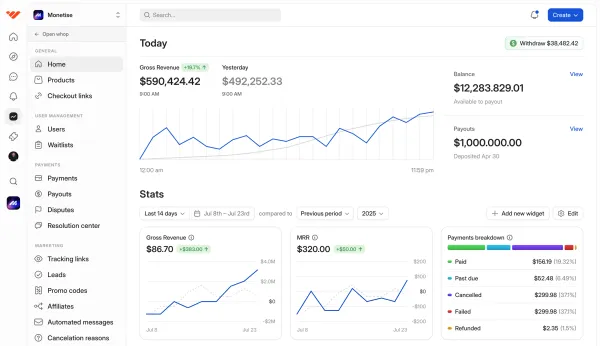Explore profitable one-person business ideas you can start online in 2025. Learn how to launch, scale, and monetize your solo business with Whop — no upfront costs.
Key takeaways
- Most one-person businesses like clipping, UGC, and online courses require zero upfront investment to start.
- Stack multiple monetization methods like courses, communities, and coaching to turn one audience into multiple income streams.
- Focus on providing real value in a specific niche rather than chasing platform-specific metrics for sustainable solopreneur success.
9-5 jobs are overrated. Policies, managers, endless meetings that really should’ve been emails. The truth is that if you’re not building your own dream, you’re building somebody else’s.
So why keep playing the game? If you’re sick of the worker bee grind, it’s time to become your own boss.
How? Pick a solo business idea that actually fits your skills and lifestyle. Something you can launch on your own, spend as much or as little time on as you wish, and scale when you decide.
Here are 14 one-person business ideas that you can launch on the side (and eventually grow to the point of quitting your desk job forever).
Let's dive in.
Best one-person business ideas
1. Clipping
Hang on a minute — what even is clipping?
Easy. You take the best moments from content that already exists, chop them into short clips, and share them. That’s it. You’re basically the hype machine for someone else’s content.
The beauty? You’re working with stuff that’s already proven to hit. You’re not guessing; you’re cutting highlights that people already love.
As far as one-person business ideas go, clipping is a no-brainer. Low effort, zero barrier to entry, and the second you find your formula? You can scale fast.
Crank up the volume, and suddenly, this little solo business idea goes from side hustle to legit money printer.
- How to get started: Join the Whop Clips community for free and learn how to start clipping from the free course and clipping community
- How much you need to invest: $0 unless you want to invest in premium editing software. There’s not really any reason to, however, since the best options like CapCut are free
- How much you can make: A single video can pull in thousands if you do things right, so there’s serious potential for revenue if you can succeed at scale
2. Creating UGC content
User-generated content (aka UGC) is basically the cheat code for making money online. If you’ve got a phone and an opinion, you can be a UGC creator.
Think about it: Amazon reviews? UGC. That TikTok unboxing vid? UGC. Even a casual selfie sipping a latte with the logo front and center counts.
Brands love this stuff because it feels real, not like a polished ad – and they’re paying creators for it.
Just ask AJ Banks. He went from working at Walmart to buying his own Tesla in just 40 days by creating UGC in response to brand opportunities posted on Whop.
- How to get started: Create a UGC portfolio and start exploring UGC platforms.
- How much you need to invest: $0 unless you want to grab some recording hardware, such as a quality microphone setup and a camera
- How much you can make: On Whop, it’s possible to make up to a few thousand dollars per video you create
3. Starting a YouTube channel
YouTube’s not a side hustle, it’s a launchpad. Forget chasing pennies from ads, though – real money comes when you use your channel as leverage.
The richest creators don’t just post and pray – they stack monetization methods: brand deals, drops, digital products, memberships.
Build an audience on YouTube, then monetize it everywhere else. YouTube gives you reach. You turn that reach into revenue.
- How to get started: The advice that most creators would give you is to create your channel and start uploading. I’ve got my own (monetized) YouTube channel, and getting that first video online was the key step
- How much you need to invest: As with other types of content, you can get started with just your mobile phone, but investing in some hardware is worth considering
- How much you can make: The top YouTube channels earn millions, but you can make a sustainable business out of your channel once you get past the 10k sub mark
4. Run a TikTok business
TikTok isn’t just for vibes; it’s a business machine.
Yeah, creators can monetize natively once you hit 10k followers and 100k views in 30 days – but that’s just the beginning. TikTok Series lets you lock longer content behind a paywall, basically turning your feed into a mini streaming service.
And the real game-changer? TikTok Shop. It’s quietly become an ecom beast—$9B in sales last year.
Pair that with affiliate marketing, UGC, and brand deals and suddenly? TikTok isn’t just a platform; it’s one of the fastest-growing solo business ideas out there.
- How to get started: Figure out whether you’d rather make TikTok videos or open a TikTok Shop, then join a TikTok community to learn exactly how to proceed
- How much you need to invest: Creating content on TikTok often doesn’t need anything more than a mobile phone, so investment is typically low to none
- How much you can make: The range is wild. Some creators clear a few hundred a month from UGC collabs. Others are stacking $10K+ when they crack TikTok Shop and viral product formulas
5. Start a podcast

Let’s be real: people are busy. Work, school, side hustles, hobbies – everyone’s juggling something. That’s why podcasts are low-key genius.
You can start them for free, and listeners can tune in while cleaning, commuting, or just zoning out. It’s effortless attention.
The trick? Pick a niche that actually matters to someone. Think hobby deep dives, hot takes on TV or gaming, industry gossip – basically, anything people will actually listen to.
Monetization? Ads, sponsorships, listener donations, or pairing your podcast with other solo business ideas like courses, digital products, or merch.
Easy to start, easy to scale, and perfect for solopreneurs who want passive income without being glued to a camera.
- How to get started: First, plan things out - what’s your niche, how long is your show, and what are the talking points? Then, pick a time, grab your gear, and go for it
- How much you need to invest: It’s very possible to get started for free, but you may want to put a few hundred dollars into quality audio recording gear or think about renting a small studio for your sessions
- How much you can make: You should be able to break even at the 1k listener mark and be able to really turn it into a viable business at ten times that figure
6. Online courses
Online courses are straight-up cash machines – we're talking $850B projected by 2030: big market, bigger opportunities.
Pick a topic you actually know or care about, then break it into bite-sized courses.
Build them using a platform with a solid course builder (videos, slides, resources) and you're done. Once it’s live, your main job is marketing.
Bonus: Stack your offerings. Add an ebook, a community, or even a podcast around your course. One course can snowball into multiple income streams.
It’s one of the cleanest, most scalable online business ideas out there.
- How to get started: Sign up to Whop, use the Courses app, and build your first course!
- How much you need to invest: Nothing – unless you want to put together video course modules with high production value
- How much you can make: Once your course is online, it’s about marketing. Each sign-up helps your revenue add up, and evergreen content can bring in money for years
7. Selling community access
Running an online community as a business? Totally normal these days – and actually smart.
Communities are revenue engines. Think of a golf or tennis club: all the perks are nice, but the real cash comes from members paying monthly. Online memberships work the same way.
Creators from YouTube to podcasts use it: exclusive content, Q&As, merch drops, early access, whatever. The trick is that people pay for premium access. To what? That's up to you.
Pro tip: don’t juggle a bunch of platforms. Pick one that handles your community and your digital products in one spot. Whop does exactly that, keeping your setup simple and your members happy.
- How to get started: Simply create your own Whop, then add apps based on what digital products you want to offer and which functions you want your online community to have
- How much you need to invest: $0 if you choose Whop, alternatives may charge hefty fees
- How much you can make: Napkin math time. How many members can you expect, and what do you want to charge per head?
8. Online coaching
Online coaching isn’t just another digital product.
It’s a one-person business that works best if you like working directly with people.
Unlike courses, which you can upload and forget, coaching is personal, interactive, and immediately valuable. People pay for you — your expertise, guidance, and attention.
To scale, move from one-on-one sessions to group coaching or small cohorts. You can also record sessions, turn them into courses, offer tiered memberships, or bundle coaching with digital products. Whop makes it all easy.
- How to get started: Sign up and set up your whop with different coaching options and apps to create a custom experience
- How much you need to invest: $0 – unless you think you need to spend on marketing
- How much you can make: Depending on your niche and expertise, you could charge clients well over $100 per hour
9. Teach online classes

Okay, so what’s the difference between online classes and online coaching? Not a ton, but here’s the gist:
Coaching is usually one-on-one — all eyes on your client for the session. Classes are more educational and happen in groups. You just need a platform that lets you manage your students and communicate easily (like Whop).
We've got a Video Calls app for live sessions, a Chat app to keep comms flowing, a Content app to keep everyone updated, and even an Events app to schedule classes. You're welcome.
The type of class is up to you. Tutoring is always solid, but if you’ve got a trading method, social media hacks, or another skill people want to learn, students will flock.
One-person business, zero overhead, full control.
- How to get started: Set up your whop and start looking for students
- How much you need to invest: $0 as long as you have a curriculum prepared and some basic video gear like a webcam ready to go
- How much you can make: If you’re able to find a consistent niche like school-leaving exams, there’s no upper limit here
10. Paid newsletters
Newsletters aren’t just marketing tools — they can be a full-blown one-person business.
Here’s the math: Charge $1 a month to 100 subscribers, that’s $100 earned. Scale that audience to 1,000? Suddenly, you’re at $1,000 a month.
Scale to a few thousand readers paying a few bucks, and you could replace a full-time job.
The secret? Content people actually want to pay for. Recipes if you’re a cook, advanced tutorials if you’re a pro photographer or designer — whatever adds value.
You can even start for free. It's easier to get sign-ups, collect emails, and build an audience. Once you’ve got their attention, selling your digital products becomes way easier.
- How to get started: Create a whop and add the forums app, and you’ve got a newsletter right there beside all of the other digital products you want to sell
- How much you need to invest: Writing up a newsletter from scratch can take a little effort, but it doesn’t need to cost a dime
- How much you can make: The math is simple, and a paid newsletter can make tens of thousands a month if you’re able to gain traction while providing consistent value
11. Sell software
Selling software is the dream — SaaS solopreneurs can make serious money if they hit the right idea. But yeah, it takes work.
Start with a problem you actually care about. Often, it’s something you’ve struggled with yourself (passion projects can make the best apps).
SaaS means subscription. Traditional software? Pay once and it’s yours. SaaS? Users pay monthly for access. Small chunks every month or one fee upfront — your call, but always think about what your customers want..
On the Whop App Store, you can list your apps, take subscriptions or one-off payments, and run it all from one spot.
- How to get started: Do some market research and try to find a problem worth fixing. Then, put a plan together detailing what resources you’ll need to start building your software
- How much you need to invest: This business model may need significant investment, especially if you need to hire developers to help you. Read how Blake Anderson built a $10m app with just $200
- How much you can make: We just spoiled it with Blake’s story, didn’t we? Software can be super profitable, and a successful app can make millions
12. PLR digital products

PLR stands for Private Label Rights. Basically, someone makes a product and sells you the right to slap your branding on it and resell it.
Say there’s a software idea you know people want, but you don’t want to code it yourself. Get it developed, add your branding, and go to market. The same goes for digital art, simple apps, coloring books — whatever you can brand and sell.
Flip it around: If you’re a creator, you can make products and sell the rights to others. Coding, design, graphics — build it once, sell it multiple times, and let bigger brands handle the heavy lifting.
Perfect for one-person businesses that want scalable income.
- How to get started: Read all about PLR digital products to get familiar with them, then strategize and figure out your approach toward this business model
- How much you need to invest: This very much depends on the type of PLR digital products you want to get into
- How much you can make: You can make plenty as a creator as well as a reseller of PLR digital products, and it’s a great complementary business idea if you already have an established brand and audience
13. Self-publish and sell ebooks
If you’ve got knowledge, a unique angle, or a message to share, ebooks are another way to turn that into a business — and they make you an author.
That title comes with clout, but without the old-school hoops: no publisher, no printing press, no annoying editor. Once they're written, you can list your ebooks on Whop and start selling instantly.
Ebooks can be your main income source, or they can boost another business.
Courses? A book adds credibility. Coaching or classes? Same deal.
- How to get started: Write your book (solo or with the help of AI), turn it into a digital file, and list it on the platforms with the lowest seller fees (hi, that's us)
- How much you need to invest: You may need to pay a graphic designer to come up with a great cover design for you, since that really makes a difference when listing on platforms where users can browse ebooks
- How much you can make: You can make tens of thousands per ebook and make it a primary income stream if you’re consistent
14. Masterminds

Mastermind groups are basically paid communities where smart, motivated people come together to level up.
Members hold each other accountable, share insights, and push each other to hit bigger goals. That’s why people pay good money to join — they want the network, the guidance, and the results.
Starting a virtual mastermind is easy. Create your own Whop and add the Masterminds app.
You handle the curation, set the price, and run the sessions — all from one platform. One-person business, scalable, and people will happily pay for access to your expertise and network.
- How to get started: Choose your niche, set a small group size, schedule regular sessions, create a simple agenda, price for value, and run it all through Whop’s Masterminds app
- How much you need to invest: $0 – unless you want to spread the word via paid ads or clipping
- How much you can make: Once you establish your reputation in your niche, you could charge thousands per seat
Start your one-person business with Whop
Launching a solo business has never been this easy.
Whop gives you all the tools to sell digital products, run communities, and get paid: no upfront costs, free to sign up, and we only take 0–3% of what you make.
Perfect whether you’re testing a side hustle or scaling big.
How to choose a one-person business idea
Picking the right one-person business isn’t one-size-fits-all — it’s gotta fit you. Start with your skills, interests, and what you actually enjoy.
Into social media? Clipping or UGC creation could work. Love gardening? Think landscaping. Sports-obsessed? Launch a fan community, sell picks, or start a podcast.
Next, check the market: is there demand? How competitive is it? Take trading as an example — tons of courses already exist, but if you offer something unique, people will notice. That’s your USP — why should anyone pick you?
Once your idea and USP are locked in, create your Whop and launch your business.
How to scale a one-person business
Wondering how much distance you can take a business solo? Surprisingly far. You don’t need full-time employees to grow — just the right know-how.
Here are some tips:
Outsource smart: Freelancers > employees (at least at first). YouTube channel? Focus on strategy and content, hire an editor. Identify roles that make sense to outsource and do it as soon as it pays off.
Build passive income: Stop grinding for every dollar. Digital products like courses earn while you sleep — upload once, keep collecting revenue.
Automate: Anything repetitive? Automate it. Excel sheets, member tracking, emails — the right tools save tons of time. TJR Trades 20x’ed revenue by automating member management and payments on Whop.
Pick the right platform: Whop handles payments, marketing, compliance, and even customer service. Less busywork, more focus on growing your business.
Launch your solo online business with Whop
Going solo doesn’t mean going it alone. Whop is your all-in-one platform for selling digital products, running communities, and managing payments, analytics, and customer support — all in one place.
No more juggling tools or hopping between platforms. We make running and scaling your one-person business simple, so you can focus on growth and keeping your audience close.
Ready to get started? Join Whop and launch your one-person business today.
FAQs
What are the best business ideas for one person?
The best business ideas for one person tend to depend on that person’s skills, expertise, and interests, but here’s a quick selection of ten great business ideas anyone can do:
- Clipping
- UGC
- Online courses
- Coaching
- Newsletters
- Online communities
- Podcasting
- YouTube
- Software
- Online classes
What is a solopreneur?
A solopreneur is an entrepreneur who takes the lone wolf approach to their business, launching and running their business all on their own.
They’ll take care of every aspect of their business themselves and hire no employees, but that doesn’t rule out outsourcing time-intensive aspects of the business to freelancers or specialist agencies.
How to start a one-person business?
Most one-person businesses start with either an idea or market research, then take care of the other one of the two in order to either narrow down on an idea or validate a chosen one.
Then, it’s a matter of finding a platform like Whop that enables you to launch the business you want with a minimum initial investment.
How to market a one-person business?
When you sign up with Whop, you’ll have your own landing page to play with. Make sure to color this in with your branding, and add SEO descriptions for all of the available fields, especially your product descriptions.
This’ll help you get found online. After that, it’s up to you to pick the right marketing strategy, such as UGC, to get your name out there.
How to price services or products?
When you launch your business, you’ll hopefully have done a little bit of market research. That should include a competitor analysis section, which would give you an idea of what other similar businesses are charging their customers.
This, factored in with your USP and any introductory pricing strategies you want to use, should give you a very good idea of where to go with pricing.
How to scale a one-person business?
When you’re scaling your one-person business, you should try to outsource as many functions as you can to skilled freelancers or specialists — whether that’s accounting and taxation or community moderation, there’s plenty of functions to outsource or delegate. Also try and focus on products that will pay you consistently over time, and if you’re creating content, it’s worth having a mix of evergreen to go alongside the viral stuff.



